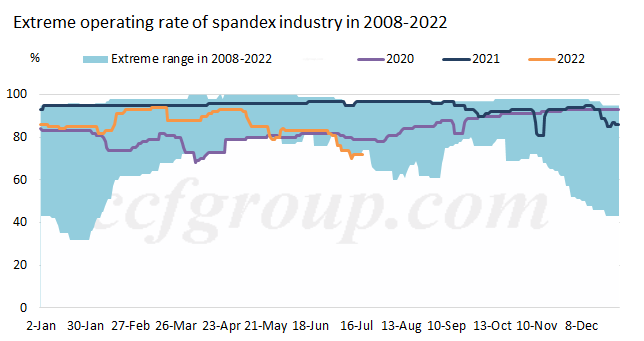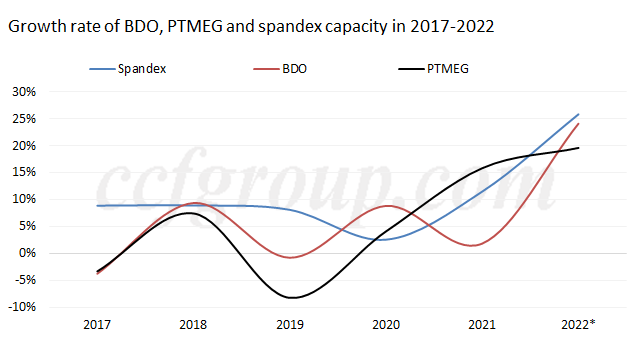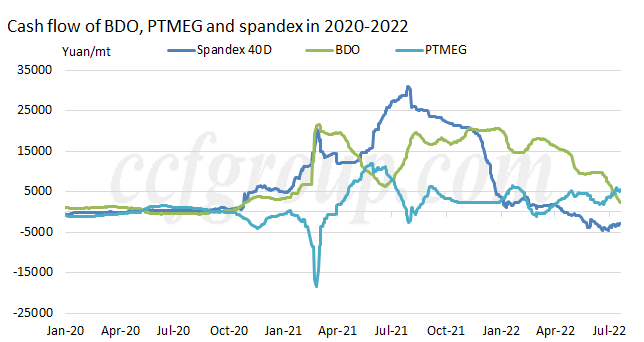Spandex: operating rate to continue descending
Apparently increasing spandex companies cut or suspended production at the end of the second quarter and in early-Q3 with weak macro market, high inflation worldwide, collapsing cost, high inventory, big losses and power rationing amid heat weather. The operating rate of spandex plants has decreased to 15-year low in Jun and Jul.

Remark: the upper limit of the O/R is multi-year high and the lower limit is multi-year low
The average operating rate of spandex industry was at 87.2% in the first half of 2022, down by 6.6 percentage points over H2 2021 and 8.3 percentage points on the year respectively. The inventory of spandex surged to historic high in early-Q3 with stunted orders. Spandex suppliers faced big selling pressure. With falling price, the stocks of spandex were obviously depreciated. The losses of spandex market expanded greatly. With strong intention to avert risk, most spandex enterprises revised down operating rate, with operating rate down to 70% after Jul.
The operating rate of spandex plants was at 72% by Jul 20. Plants in East China ran at lower capacity at 71% and those in Midwest China ran at 76% of capacity. Some units with high efficiency and low cost also scaled down the production of stagnated resources in Midwest China. Spandex plants integrated with PTMEG supply ran at 95% of capacity and those without PTMEG production ran at near 67% of capacity.
Why did the operating rate of spandex plants keep falling and reduce to multi-year low?
Firstly, it was because of soft demand. The consumption of textiles and apparels grew without strong momentum under economic downturn pressure. New export orders also slipped. The operating rate and orders of fabric mills was worse than the same period of last year. Some fabric mills even turned to produce fabrics without spandex or with low content of spandex. Middlemen rarely replenished, mainly with lower than one week of stocks. Demand for spandex dwindled. The inventory burden was mainly among spandex suppliers.
Secondly, the whole spandex value chain entered capacity expansion peak. The growth rate of capacity of BDO, PTMEG and spandex was all near 20% and hit multi-year new high. However, demand for spandex saw rare negative growth as the consumption of textiles and apparels lacked upward momentum. The promotion of biodegradable plastics was slow with slower growth rate of GDP. Upstream market also encountered strong supply but weak demand. Some feedstock suppliers cut price for promotion amid unbalanced supply and demand. Price of PTMEG and BDO accelerated reducing in Jul. With stronger risk-aversion mindset, spandex companies cut run rate.

Thirdly, the whole value chain was still under weakness and in downward streak. The cash flow of the whole value chain still had shrinking space. As price of PTMEG and BDO extended lower and has not touched historic low, spandex plants controlled operating rate to reduce losses amid high inventory. The losses of spandex plants based on spot raw material prices have hit the highest since the COVID-19 pandemic in end-Q2 and early-Q3 of 2022. The inventory of spandex was near 50 days and has been devalued. Therefore, the actual losses of spandex companies was bigger.

With plunging feedstock price, great losses and muted sales, spandex plants were forced to cut or suspend production. However, the production of some plants in East China were impacted by the power rationing in summer and the pipe renovation of steam and sewage pipeline. The operating rate of spandex plants is estimated to extend lower in short run.
- Top keywords
- Cotton Price
- Cotton Futures Price
- Cotton Futures
- CZCE
- PTA Futures Price
- Chemical Fiber
- Polyester Prices
- Wool price
- PTA Futures
- Shengze Silk
- China
- Yarn Price
- price
- China Textile City
- Fibre Price
- Benzene Price
- Cotton
- Index
- Cotton Index
- PTA
- fabric price
- NYMEX
- Top 10
- textile industry
- Spot Cotton
- Cotton Yarn
- Polyester Price
- Futures
- PTA Price
- cotton yarn price

